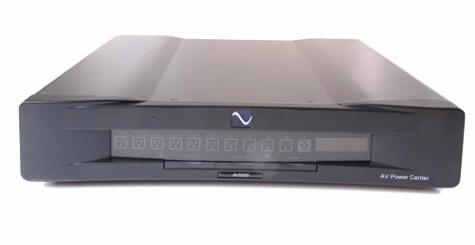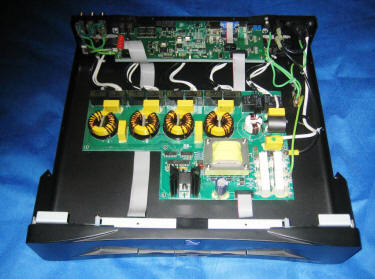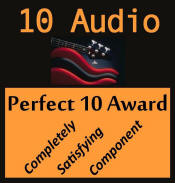The PS Audio AV Power Center 5000 is a remarkable device with an extensive list of features that places it at the very forefront of this product category. From the PS Audio Web site:

“The Audio Video Power Center AV-5000 is one of the most advanced power conditioners we have ever built… Full chassis sized component, touchscreen interface, 5 IsoZones, and 10 independently controlled outlets. Setup and control the AV-5000 when connected to your local network via it’s built in web server, your universal remote, or your control system via RS-232.
“The AV-5000 has 10 individually switched PowerPort outlets, grouped into 5 isolated AC power zones. Each zone has both common mode as well as differential mode AC cleaning that combined lowers noise by an amazing 80dB. For the safety of connected equipment, the AV-5000 features 7344 Joules of spike protection as well as fully automated over/under voltage control for surges.”
A full discussion of the features and configuration options would take up much more space than usual, but I will summarize with just a few of the features that I enjoy most:
— Ability to individually set each of the 10 outlets to be always on, switched on by the front panel square push button, or with a turn-on delay, all through a Web page network interface: http://PowerCenter.
— Set a turn-off delay to protect components, especially speakers.
— Change the name of each input so I remember what is plugged in to which outlet.
— Change the brightness of the display.
— Remote trigger to turn on and off other components. This has changed my “go sequence” from manually turning on the preamp, DAC, and two mono power amplifiers (4 power-up steps) to simply pushing the power button on the AV-5000 (1 power-up step). I don’t have to remember the safe turn on sequence – DAC, then preamp, then the power amps – or risk a dangerous pop in my speakers. Likewise, a safe turn-off sequence is guaranteed, regardless of my ability at the end of a listening session to remember the exact order.
Even with all of the set up and configuration options, the AV-5000 is simple to operate, and the settings are easily changed. Many of the settings are accessible from the touch-sensitive front panel of the AV-5000, but changing the advanced functions requires a computer interface. Based on the feedback I have received from a recent survey, most of you have either already integrated computers into your audio systems or are planning to do so in the not too distant future. As those who have made the leap to music servers already understand, this technology is the future. Computer access is not going to be a problem for most users.

My stereo system during the review included YG Acoustics Kipod Main Modules and Merlin TSM-MMe loudspeakers, Velodyne Optimum 12 subwoofers; Marantz MA-9S2, Manley Snapper and Parasound JC-1 amplifiers (all mono blocks); Sonic Frontiers Line 2SE+, Krell KAV-280P and Levinson N380S preamplifiers; Prism Orpheus Digital Interface – which serves as a DAC, phono preamp and line preamp; custom Windows 7 computer/music server; SOTA Cosmos IV turntable with Triplanar VIIu2 tonearm and Miyajima Shilabe moving coil phono cartridge. All interconnects are Mogami, with Mogami and Element Apollo speaker cables. I enjoyed PS Audio PerfectWave AC-12 and Jerry’s DIY power cables.
I installed the $799.99 list price AV-5000, plugging all my front-end gear into the outlets and grouping similar types of devices when possible into their own Zones, turned it on and ignored it for a few weeks. The network Ethernet cable was eventually moved from the music server computer to the AV-5000 and I tweaked the settings over several weeks of use to get to the “one-button start up” that I enjoy every day. At this point, the system was sounding better than ever, night after night. There had been other component changes during this period and I was not sure which change had caused the system to really lock-in and sound musically whole and organically complete: a totally synergistic music system.
Then, after six weeks of daily use, I disconnected all of the components from the AV-5000 and plugged everything into a regular, but high quality, power strip. I continued to use the same PS Audio PerfectWave AC-12 power cable from the wall to the power strip that was used with the AV-5000.
And my system instantly sounded like crap.
I am sorry to be so blunt and coarse, but the very engaging and enjoyable musical qualities that I had been enjoying for weeks immediately and unequivocally took a startlingly obvious turn for the worse. Specifically, image depth decreased by about 75% and there was a layer of fine haze or roughness in the midrange and lower treble. Sibilants, or the “es” sounds, became raspy and harsh. In music that has a number of singers, their individuality became much less apparent and their specific locations on the sound stage blended together. This was very noticeable on Paul Simon’s “Homeless”, from the Graceland LP (Warner Bros. UK:WX 52), a 180 gram pressing that is musically and technically excellent. Instead of clearly identifiable positions for each singer, both left-to-right and front-to-back, there was a poorly localized “wall-of-sound”. Now, if all I knew about this fine album was that it offered a poorly localized “wall-of-sound”, I would have thought it sounded pretty good. But after listening to this album several times over the past six weeks with the AV-5000 in use, and then again immediately prior to removing it, I offer the follow observation with complete confidence: Listening to music with the PS Audio AV-5000 power conditioner is much more satisfying than listening to music without it.

There are many reports that different power conditioners detract from the dynamic impact of music, robbing the sound of life and energy. My experiences with some other conditioners had, more or less, confirmed the potential for this unwanted effect. However, when I removed the AV-5000, dynamics suffered and the music sounded as if a compressor had been turned on, not off. This limited not only the large transients that give music its energy and momentum, but also the small, micro dynamic impulses that help make recorded music sound real and alive. Reinstalling the AV-5000 restored the lifelike dynamic impact of the music. In fact, the feeling I had when listening without the AV-5000 installed was to hurry through writing these listening notes and reinstall the AV Power Center ASAP.
I live in the suburbs and all of the wiring in our neighborhood is underground. I usually find that power conditioners have a positive effect on the quality of sound during the daytime and early evening. Approaching midnight, the reverse is often true and my systems usually sound better without any power conditioning. This was not true with the AV-5000, as performance of my audio system is improved significantly all the time, day or night, with the PS Audio conditioner installed. This is a first. There are easily noticeable improvements in clarity, smoothness, resolution, coherence of harmonics, background silence, dynamic and transient impact and speed, and the size of the sound stage with the AV-5000 installed, 24/7. The cumulative effect of filtering and isolation from other components is apparent in the relaxed but high resolution musical images that welcomes your involvement.
This is 10 Audio and not 10 Video, but despite that distinction, I moved the AV-5000 upstairs to the home theater system and connected my HD Toshiba 56HM195 DLP television to see the effect on a video device. Several years ago, I reviewed the PS Audio Ultimate Outlet and tested its video performance on a different television, a heavy picture tube-type (very “last century” technology!) Sony 32” set. I noted a minor improvement at that time with the UO. Connecting the DLP TV to the PS Audio AV power conditioner resulted in a small but noticeable improvement in the blackness of blacks and the resolution of fine detail, such as individual strands of hair or fur, depending on the species. In images with large areas of a light solid color, there was a small but worthwhile improvement in the continuousness and purity of the solid color compared to the Tripp Lite Isobar 8 that is normally used with this television. A Video Essentials test DVD made it possible to view the same images before and after the power conditioner was installed. If my personal interests included the same level of dedication (or maybe “obsession” is more accurate) to maximizing the performance of my home theater system, it would have an AV-5000 installed permanently.
I compared the AV-5000 to a Monster Cable HTS-5100 mk2 Home Theater Reference Power Center, which is identically priced and has many features in common. The HTS followed more closely my general experience with power conditioners as noted above, except that the Monster product was barely beneficial during the afternoon when power line pollution is at its worst. Even in the early evening, when the quality of power begins to improve, the HTS had a detrimental effect on the quality of sound in my system. The build quality of the PS Audio power conditioner is far superior to the Monster device. I had a PS Audio PowerPlant Premier last year, but the only current component that was used with the PPP is the SOTA Cosmos turntable. That one component cannot provide enough information to reliably determine a preference between the two PS Audio conditioners, and I no longer have the PPP for a direct comparison.

I have a couple of gripes and product suggestions. First, I would like to be able to turn off the front panel illumination when the system is turned off. Leaving just a small indicator on would cut the light pollution in the room when it is not being used for listening. Second, there are surge protected Ethernet in and out ports, which are not really necessary on a closed Local Area Network (LAN). It would be a much better use of the limited real estate on the rear panel if the AV-5000 included a 3-port gigabit network switch so I could connect my network to the main Ethernet port to access the AV-5000’s set up menus, and then use the other ports to connect my music computer to the network, and possibly an Internet-enabled HDTV or Blu-Ray player. It seems like this is a feature which the AV-5000 should provide! And lastly, the user’s manual could be more helpful if it contained a bit more information about the parallel filtering power outlets, which are for power amplifiers, and more specifications for the different levels of filtering and noise reduction for the different power zones. This would help to better understand which zones to use for which type of component – analog, digital, or motorized (turntables). But these are minor points and do not affect the audio performance of the power conditioner.
In the course of this review, I could have connected one component at a time to the AV-5000 to hear the additive effect of filtering additional components. But why? You won’t use it that way and the observations would have only academic interest. Much more relevant is what happens to the overall system sound when all of your components are connected to the PS Audio power conditioner. Allowing the AV-5000 to provide power for the entire system elevated the musical performance of my audio system far higher than the nominal cost of the conditioner could predict. In fact, in all my years of critical listening, I don’t recall another single component that has offered a greater degree of overall improvement. How would I defend that conclusion? With this listening observation: CDs sound better with the AV-5000 than LPs sound without it.
The PS Audio AV Power Conditioner 5000 is a highly effective power conditioner that I can confidently recommend. Removing it is certainly an option: an unpleasant one. I am buying the review sample.
Overall Rating: 10 LPs

Manufacturer’s Web site: PS Audio
